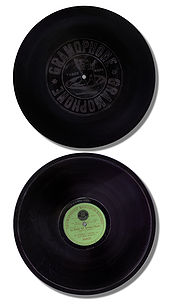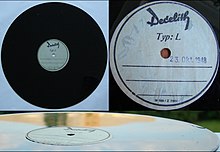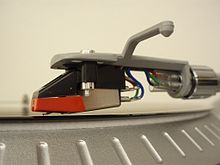A phonograph record (also known as a gramophone record, especially in British English), a vinyl record (for later varieties only), or simply a record or vinyl is an analog sound storage medium in the form of a flat disc with an inscribed, modulated spiral groove. The groove usually starts near the outside edge and ends near the center of the disc. The stored sound information is made audible by playing the record on a phonograph.
Until the 1940s, for about half a century, the discs were commonly made from shellac, with earlier records having a fine abrasive filler mixed in. The "vinyl" records of the late 20th century, made from polyvinyl chloride (PVC), then became commonplace.
Overview

The phonograph record was the primary medium used for music reproduction throughout the 20th century. It had co-existed with the phonograph cylinder from the late 1880s and had effectively superseded it by around 1912. Records retained the largest market share even when new formats such as the compact cassette were mass-marketed. By the 1980s, digital media, in the form of the compact disc, had gained a larger market share, and the record left the mainstream in 1991.[1] Since the 1990s, records continue to be manufactured and sold on a smaller scale, and during the 1990s and early 2000s were commonly used by disc jockeys (DJs), especially in dance music genres. They were also listened to by a growing number of audiophiles. The phonograph record has made a niche resurgence as a format for rock music in the early 21st century—9.2 million records were sold in the US in 2014, a 260% increase since 2009.[2] Likewise, sales in the UK increased five-fold from 2009 to 2014.[3]
Phonograph records are generally described by their diameter in inches (12-inch, 10-inch, 7-inch) (although they were designed in millimeters[4]), the rotational speed in revolutions per minute (rpm) at which they are played (8+1⁄3, 16+2⁄3, 33+1⁄3, 45, 78),[5] and their time capacity, determined by their diameter and speed (LP [long play], 12-inch disc, 33+1⁄3 rpm; SP [short play or single play], 10-inch disc, 78 rpm, or 7-inch disc, 45 rpm; EP [extended play], 12-inch disc or 7-inch disc, 33+1⁄3 or 45 rpm); their reproductive quality, or level of fidelity (high-fidelity, orthophonic, full-range, etc.); and the number of audio channels (mono, stereo, quad, etc.).
The phrase broken record refers to a malfunction[6] when the needle skips/jumps back to the previous groove and plays the same section over and over again indefinitely.[7][8][9]
Continued production
As of 2017, 48 record pressing facilities exist worldwide, 18 in the US and 30 in other countries. The increased popularity of the record has led to the investment in new and modern record-pressing machines.[10] Only two producers of lacquers (acetate discs or master discs) remain: Apollo Masters in California, and MDC in Japan.[11] On 6 February 2020, a fire destroyed the Apollo Masters plant. According to the Apollo Masters website, their future is still uncertain.[12]
History
Manufacture of disc records began in the late 19th century, at first competing with earlier cylinder records. Price, ease of use and storage made the disc record dominant by the 1910s. The standard format of disc records became known to later generations as "78s" after their playback speed in revolutions per minute, although that speed only became standardized in the late 1920s. In the late 1940s new formats pressed in vinyl, the 45 rpm single and 33 rpm long playing "LP", were introduced, gradually overtaking the formerly standard "78s" over the next decade. The late 1950s saw the introduction of stereophonic sound on commercial discs.
Predecessors
The phonautograph was invented by 1857 by Frenchman Édouard-Léon Scott de Martinville.[13] It could not, however, play back recorded sound,[14] as Scott intended for people to read back the tracings,[15] which he called phonautograms.[16] Prior to this, tuning forks had been used in this way to create direct tracings of the vibrations of sound-producing objects, as by English physicist Thomas Young in 1807.[17]
In 1877, Thomas Edison invented the first phonograph,[18] which etched sound recordings onto phonograph cylinders. Unlike the phonautograph, Edison's phonograph could both record and reproduce sound, via two separate needles, one for each function.[19]
The first disc records

The first commercially sold disc records were created by Emile Berliner in the 1880s. Emile Berliner improved the quality of recordings while his manufacturing associate Eldridge R. Johnson, who owned a machine shop in Camden, New Jersey, eventually improved the mechanism of the gramophone with a spring motor and a speed regulating governor, resulting in a sound quality equal to Edison's cylinders. Abandoning Berliner's "Gramophone" trademark for legal reasons in the United States, Johnson's and Berliner's separate companies reorganized in 1901 to form the Victor Talking Machine Company in Camden, New Jersey, whose products would come to dominate the market for several decades.[20]
Berliner's Montreal factory, which became the Canadian branch of RCA Victor, still exists. There is a dedicated museum in Montreal for Berliner (Musée des ondes Emile Berliner).[21]
78 rpm disc developments

Early speeds
Early disc recordings were produced in a variety of speeds ranging from 60 to 130 rpm, and a variety of sizes. As early as 1894, Emile Berliner's United States Gramophone Company was selling single-sided 7-inch discs with an advertised standard speed of "about 70 rpm".[22]
One standard audio recording handbook describes speed regulators, or governors, as being part of a wave of improvement introduced rapidly after 1897. A picture of a hand-cranked 1898 Berliner Gramophone shows a governor, and says that spring drives had replaced hand drives. It notes that:
The speed regulator was furnished with an indicator that showed the speed when the machine was running so that the records, on reproduction, could be revolved at exactly the same speed...The literature does not disclose why 78 rpm was chosen for the phonograph industry, apparently this just happened to be the speed created by one of the early machines and, for no other reason continued to be used.[23]

In 1912, the Gramophone Company set 78 rpm as their recording standard, based on the average of recordings they had been releasing at the time, and started selling players whose governors had a nominal speed of 78 rpm.[24] By 1925, 78 rpm was becoming standardized across the industry. However, the exact speed differed between places with alternating current electricity supply at 60 hertz (cycles per second, Hz) and those at 50 Hz. Where the mains supply was 60 Hz, the actual speed was 78.26 rpm: that of a 60 Hz stroboscope illuminating 92-bar calibration markings. Where it was 50 Hz, it was 77.92 rpm: that of a 50 Hz stroboscope illuminating 77-bar calibration markings.[24]
Acoustic recording
Early recordings were made entirely acoustically, the sound was collected by a horn and piped to a diaphragm, which vibrated the cutting stylus. Sensitivity and frequency range were poor, and frequency response was irregular, giving acoustic recordings an instantly recognizable tonal quality. A singer almost had to put their face in the recording horn. A way of reducing resonance was to wrap the recording horn with tape.[25]
Even drums, if planned and placed properly, could be effectively recorded and heard on even the earliest jazz and military band recordings. The loudest instruments such as the drums and trumpets were positioned the farthest away from the collecting horn. Lillian Hardin Armstrong, a member of King Oliver's Creole Jazz Band, which recorded at Gennett Records in 1923, remembered that at first Oliver and his young second trumpet, Louis Armstrong, stood next to each other and Oliver's horn could not be heard. "They put Louis about fifteen feet over in the corner, looking all sad."[26][27]
Electrical recording

During the first half of the 1920s, engineers at Western Electric, as well as independent inventors such as Orlando Marsh, developed technology for capturing sound with a microphone, amplifying it with vacuum tubes[28] (known as valves in the UK[29]), and then using the amplified signal to drive an electromechanical recording head. Western Electric's innovations resulted in a broader and smoother frequency response, which produced a dramatically fuller, clearer and more natural-sounding recording. Soft or distant sounds that were previously impossible to record could now be captured. Volume was now limited only by the groove spacing on the record and the amplification of the playback device. Victor and Columbia licensed the new electrical system from Western Electric and recorded the first electrical discs during the spring of 1925. The first electrically recorded Victor Red Seal record was Chopin's "Impromptus" and Schubert's "Litanei" performed by pianist Alfred Cortot at Victor's studios in Camden, New Jersey.[28]
A 1926 Wanamaker's ad in The New York Times offers records "by the latest Victor process of electrical recording".[30] It was recognized as a breakthrough; in 1930, a Times music critic stated:
... the time has come for serious musical criticism to take account of performances of great music reproduced by means of the records. To claim that the records have succeeded in exact and complete reproduction of all details of symphonic or operatic performances ... would be extravagant ... [but] the article of today is so far in advance of the old machines as hardly to admit classification under the same name. Electrical recording and reproduction have combined to retain vitality and color in recitals by proxy.[31]


The Orthophonic Victrola had an interior folded exponential horn, a sophisticated design informed by impedance-matching and transmission-line theory, and designed to provide a relatively flat frequency response. Victor's first public demonstration of the Orthophonic Victrola on 6 October 1925, at the Waldorf-Astoria Hotel was front-page news in The New York Times, which reported:
The audience broke into applause ... John Philip Sousa [said]: '[Gentlemen], that is a band. This is the first time I have ever heard music with any soul to it produced by a mechanical talking machine' ... The new instrument is a feat of mathematics and physics. It is not the result of innumerable experiments, but was worked out on paper in advance of being built in the laboratory ... The new machine has a range of from 100 to 5,000 [cycles per second], or five and a half octaves ... The 'phonograph tone' is eliminated by the new recording and reproducing process.[33]
Sales of records plummeted precipitously during the early years of the Great Depression of the 1930s, and the entire record industry in America nearly foundered. In 1932, RCA Victor introduced a basic, inexpensive turntable called the Duo Jr., which was designed to be connected to their radio receivers. According to Edward Wallerstein (the general manager of the RCA Victor Division), this device was "instrumental in revitalizing the industry".[34]
78 rpm materials
The production of shellac records continued throughout the 78 rpm era, which lasted until 1948 in industrialized nations.[35]
During the Second World War, the United States Armed Forces produced thousands of 12-inch vinyl 78 rpm V-Discs for use by the troops overseas.[36] After the war, the use of vinyl became more practical as new record players with lightweight crystal pickups and precision-ground styli made of sapphire or an exotic osmium alloy proliferated. In late 1945, RCA Victor began offering "De Luxe" transparent red vinylite pressings of some Red Seal classical 78s, at a de luxe price. Later, Decca Records introduced vinyl Deccalite 78s, while other record companies used various vinyl formulations trademarked as Metrolite, Merco Plastic, and Sav-o-flex, but these were mainly used to produce "unbreakable" children's records and special thin vinyl DJ pressings for shipment to radio stations.[37]
78 rpm recording time
The playing time of a phonograph record is directly proportional to the available groove length divided by the turntable speed. Total groove length in turn depends on how closely the grooves are spaced, in addition to the record diameter. At the beginning of the 20th century, the early discs played for two minutes, the same as cylinder records.[38] The 12-inch disc, introduced by Victor in 1903, increased the playing time to three and a half minutes.[39] Because the standard 10-inch 78 rpm record could hold about three minutes of sound per side, most popular recordings were limited to that duration.[40] For example, when King Oliver's Creole Jazz Band, including Louis Armstrong on his first recordings, recorded 13 sides at Gennett Records in Richmond, Indiana, in 1923, one side was 2:09 and four sides were 2:52–2:59.[41]
In January 1938, Milt Gabler started recording for Commodore Records, and to allow for longer continuous performances, he recorded some 12-inch discs. Eddie Condon explained: "Gabler realized that a jam session needs room for development." The first two 12-inch recordings did not take advantage of their capability: "Carnegie Drag" was 3m 15s; "Carnegie Jump", 2m 41s. But at the second session, on 30 April, the two 12-inch recordings were longer: "Embraceable You" was 4m 05s; "Serenade to a Shylock", 4m 32s.[42][43] Another way to overcome the time limitation was to issue a selection extending to both sides of a single record. Vaudeville stars Gallagher and Shean recorded "Mr. Gallagher and Mr. Shean", written by themselves or, allegedly, by Bryan Foy, as two sides of a 10-inch 78 in 1922 for Victor.[44] Longer musical pieces were released as a set of records. In 1903 HMV in England made the first complete recording of an opera, Verdi's Ernani, on 40 single-sided discs.[45]
In 1940, Commodore released Eddie Condon and his Band's recording of "A Good Man Is Hard to Find" in four parts, issued on both sides of two 12-inch 78s. The limited duration of recordings persisted from their advent until the introduction of the LP record in 1948. In popular music, the time limit of 3+1⁄2 minutes on a 10-inch 78 rpm record meant that singers seldom recorded long pieces. One exception is Frank Sinatra's recording of Rodgers and Hammerstein's "Soliloquy", from Carousel, made on 28 May 1946. Because it ran 7m 57s, longer than both sides of a standard 78 rpm 10-inch record, it was released on Columbia's Masterwork label (the classical division) as two sides of a 12-inch record.[46]
In the 78 era, classical-music and spoken-word items generally were released on the longer 12-inch 78s, about 4–5 minutes per side. For example, on 10 June 1924, four months after the 12 February premier of Rhapsody in Blue, George Gershwin recorded an abridged version of the seventeen-minute work with Paul Whiteman and His Orchestra. It was released on two sides of Victor 55225 and ran for 8m 59s.[47]
Record albums
"Record albums" were originally booklets containing collections of multiple disc records of related material, the name being related to photograph albums or scrap albums. [48] German record company Odeon pioneered the album in 1909 when it released the Nutcracker Suite by Tchaikovsky on four double-sided discs in a specially designed package.[45] It was not until the LP era that an entire album of material could be included on a single record.
78 rpm releases in the microgroove era
In 1968, when the hit movie Thoroughly Modern Millie was inspiring revivals of Jazz Age music, Reprise planned to release a series of 78-rpm singles from their artists on their label at the time, called the Reprise Speed Series. Only one disc actually saw release, Randy Newman's "I Think It's Going to Rain Today", a track from his self-titled debut album (with "The Beehive State" on the flipside).[49] Reprise did not proceed further with the series due to a lack of sales for the single, and a lack of general interest in the concept.[50]
In 1978, guitarist and vocalist Leon Redbone released a promotional 78-rpm single featuring two songs ("Alabama Jubilee" and "Please Don't Talk About Me When I'm Gone") from his Champagne Charlie album.[51]
In the same vein of Tin Pan Alley revivals, R. Crumb & His Cheap Suit Serenaders issued a number of 78-rpm singles on their Blue Goose record label. The most familiar of these releases is probably R. Crumb & His Cheap Suit Serenaders' Party Record (1980, issued as a "Red Goose" record on a 12-inch single), with the double-entendre "My Girl's Pussy" on the "A" side and the X-rated "Christopher Columbus" on the "B" side.
In the 1990s Rhino Records issued a series of boxed sets of 78-rpm reissues of early rock and roll hits, intended for owners of vintage jukeboxes. The records were made of vinyl, however, and some of the earlier vintage 78-rpm jukeboxes and record players (the ones that were pre-war) were designed with heavy tone arms to play the hard slate-impregnated shellac records of their time. These vinyl Rhino 78s were softer and would be destroyed by old juke boxes and old record players, but play well on newer 78-capable turntables with modern lightweight tone arms and jewel needles.[52]
As a special release for Record Store Day 2011, Capitol re-released The Beach Boys single "Good Vibrations" in the form of a 10-inch 78-rpm record (b/w "Heroes and Villains"). More recently, The Reverend Peyton's Big Damn Band has released their tribute to blues guitarist Charley Patton Peyton on Patton on both 12-inch LP and 10-inch 78s.[53]
New sizes and materials after WWII: 45 rpm singles, LPs, and vinyl records



CBS Laboratories had long been at work for Columbia Records to develop a phonograph record that would hold at least 20 minutes per side.[54][55]